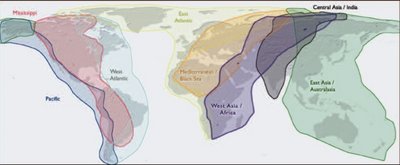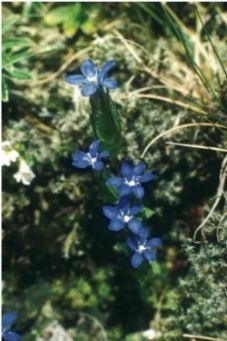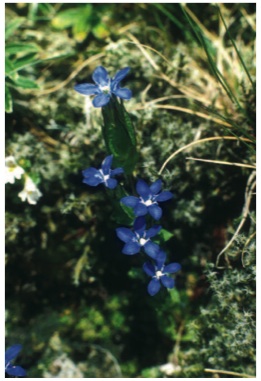Conservation of arctic species
This is Section 10.2.6 of the Arctic Climate Impact Assessment
Lead Author: Michael B. Usher; Contributing Authors:Terry V. Callaghan, Grant Gilchrist, Bill Heal, Glenn P. Juday, Harald Loeng, Magdalena A. K. Muir, Pål Prestrud
The Arctic is generally species-poor compared with other large geographical areas of the world. There are, however, a number of charismatic species that capture people’s imagination; including the polar bear, the reindeer or caribou (Rangifer tarandus), the gyrfalcon (Falco rusticolus), and the apparently frail Arctic poppy (Papaver polare). Terrestrial mammals number only 48 species, although some might be more properly considered as subarctic species, straying into the Arctic by a short distance only. Of these 48 species, 9 occur in Greenland, 29 in Alaska, 31 in the Canadian Arctic, and 33 in the Russian Arctic. Sage[1] lists these species, but noted some taxonomic uncertainties which could result in these numbers changing slightly following further taxonomic research. Corresponding figures for breeding birds, noting the caveat that some species breed only very occasionally in the Arctic, are 183 for the Arctic as a whole, and 61, 113, 105, and 136 for Greenland, Alaska, Canada, and Russia respectively.
Arctic species, especially mammals and birds, feature strongly in books on wildlife[2] and ecology[3]. The purpose of this section is not to list the species of the Arctic, but to reinforce the ecological characteristics of the species that live in the Arctic. An understanding of these characteristics is essential for the conservation management of the Arctic’s biodiversity.
The main characteristic essential for a species to survive in the Arctic is the ability to cope with cold temperatures. Most species have evolved strategies for surviving the arctic winter, i. e., cold tolerance, with the remainder developing strategies for cold avoidance. There are many ways of developing cold tolerance. For mammals that spend the whole year in the Arctic, this often involves depositing a layer of fatty tissue under the skin, as occurs in species of whales and seals. These species provide a valuable resource for the local human populations that harvest them for meat and for the oil that can be extracted from the blubber. A similar physiological system is used in some seabirds, such as the Atlantic puffin (Fratercula arctica), a vital oily food in the diet of the former inhabitants of the North Atlantic island of St. Kilda[4].
Invertebrate animals have a different system of cold tolerance. They accumulate glycerol in their tissues and, although they are usually susceptible to freezing, are able to "supercool" whereby the body fluids remain liquid at temperatures well below the freezing point[5]. The majority of the alpine, arctic, and antarctic insects and mites are able to supercool, developing glycerol concentrations of up to 42 µg/mg of fresh weight and being able to survive temperatures below -15 °C[6]. This has an effect on the life cycles of these invertebrates in that they cannot reach the reproductive state until they are two to three years old, largely because they have to empty their guts before they supercool and have relatively limited opportunities for growth during the short arctic summer[7]. However, it is known that some species enter a reproductive diapause when reared at constant temperature in the laboratory (e. g., the collembolan Hypogastrura tullbergi), and that this diapause can only be terminated by exposure to cold. This poses the question as to whether, with the warming of the terrestrial environment, some invertebrate species may be unable to breed. Hodkinson et al.[8] have reviewed the whole subject in relation to invertebrates that live in arctic soils.
 Fig. 10. 4. The eight main international flyways used by shorebirds (waders) on migration. Within each flyway reasonably constant routes are used between the breeding grounds and the wintering grounds, although the southbound and northbound routes might differ. Each flyway comprises many different individual routes used by the different species and by different populations within a species. All arctic areas used by breeding shorebirds are included in these eight flyways.[9]
Fig. 10. 4. The eight main international flyways used by shorebirds (waders) on migration. Within each flyway reasonably constant routes are used between the breeding grounds and the wintering grounds, although the southbound and northbound routes might differ. Each flyway comprises many different individual routes used by the different species and by different populations within a species. All arctic areas used by breeding shorebirds are included in these eight flyways.[9] Cold avoidance is a strategy adopted by a number of species of vertebrate animals. Arctic rodents, such as the insular vole (Microtus abbreviatus) of the Alaskan and Canadian Arctic, avoid the coldest conditions by living within or under the snow[10]. Reindeer and caribou migrate to the forest on the southern edge of the Arctic, to over-winter in the more sheltered conditions of the boreal forest, before migrating north in the spring to the arctic tundra grazing grounds. Many of the fish species of the Arctic Ocean follow the edge of the sea ice in its seasonal movements southward during the autumn/winter and northward in the spring/summer.
Some species of bird have perfected the cold avoidance strategy by undergoing long-distance migrations. BirdLife[11] featured the movement of the buffbreasted sandpiper (Tryngites subruficollis) which nests predominantly in the Canadian Arctic (with a small population in the Alaskan Arctic), but over-winters in South America in an area stretching from southern Brazil, through the northeast corner of Argentina, and into Paraguay. This is an example of one of the eight recognized flyways, known as the Mississippi Flyway, for shorebirds that breed in the Arctic[12]. Figure 10. 4 shows the routes between the arctic breeding grounds, the staging areas which allow the birds to feed while they are en route, and the wintering grounds (which are often in the Southern Hemisphere). Conservation efforts for these migratory species must be international so that the species gain protection along the whole of flyway as well as in the arctic breeding grounds.
It is more difficult to characterize the strategies of plants in terms of cold tolerance or cold avoidance. Virtually all arctic plants are perennial, and so are able to reproduce over several years or remain in a vegetative state until climatic conditions in a particular year favor reproduction. Perennial plants have over wintering organs, such as roots and buds, which are protected by snow or soil from the coldest temperatures. One of the very few annual species is the snow gentian (Gentiana nivalis), which occurs in the north American Arctic and Greenland; in Europe it is predominantly a mountain species (Fig. 10. 5). The snow gentian flowers and sets seed rapidly in the summer, and is said to have a seed bank so that it can survive climatically adverse years without flowering or with very restricted flowering, and hence demonstrates extreme year-to-year variability in population size[13].
Anoxia is a potential problem for species that overwinter in the Arctic. Marine mammals surface in order to obtain fresh air, and use a number of ways to maintain breathing holes in sea ice. The migration of fish in relation to the extent of the sea ice may also be related to the oxygen content of the seawater as well as to temperature. Terrestrial invertebrates have also developed mechanisms to cope with anoxia: for example, the two mite species studied by Sømme and Conradi-Larsen[14] survived for at least three months at 0 °C under anoxic conditions, whereas a species from further south in Norway died within six to eight days under similar conditions. Arthropods form lactate under anoxic conditions, with concentrations rising to nearly 2 µg/mg fresh weight, indicating this as a possible mechanism for coping with the anaerobic conditions that might prevail in arctic soils during winter.
As well as developing strategies for cold tolerance and cold avoidance, arctic species need to cope with freeze– thaw cycles in spring and autumn, and warm conditions in summer when there might be excess water due to the ice melt or desiccation due to low precipitation[15]. Over the year, each species has to be able to survive many ecological conditions. This is particularly evident in two features of arctic populations: extended life cycles and extreme year-to-year variability in population size.
It has already been mentioned that very few arctic plant species are annuals, and that the soil arthropods are generally not reproductive until two or three years old (whereas in temperate Europe and North America such species would have at least one generation per year). An example of the extended life cycle was given by CAFF[16] where the life cycle of "woolly bear" larva of the moth Gynaephora groenlandicacan vary from 7 to 14 years. In much of northern Europe and America such "woolly bears" (of other moth species) have an annual life cycle.
There is often extreme year-to-year variability in the sizes of arctic populations. This is particularly evident in relation to the occasional outbreaks of the autumnal moth, Epirrita autumnata. The larvae of this moth can cause widespread defoliation of downy birch (Betula pubescens) trees, for example in Arctic Finland, and in the most severe cases the trees subsequently die. These two features of arctic populations – the extended life cycles and the extreme fluctuations in size – both make conservation management, and particularly the monitoring of species, more difficult.
Although the Arctic might be species-poor compared to other regions of the world, there are very few arctic species that are currently threatened with extinction. BirdLife[17] produced a world map, shaded from white (no species of bird known to be threatened with extinction), through shades of yellow and orange, to red (where at least 25 species are threatened). The majority of the Arctic is white, although there are some areas of pale yellow in the Russian Arctic. How this map might change with climatic warming (Climate change) is not known, but the situation in the Arctic at the start of the 21st century is healthier than in virtually any other major geographical region. If the arctic environment is conserved, with particular attention given to arctic ecosystems[18], it is possible that a smaller proportion of the Arctic’s species will be threatened with extinction than in other geographical areas.
This ecosystem approach to conservation has been defined as "the comprehensive integrated management of human activities based on best available scientific knowledge about the ecosystem and its dynamics, in order to identify and take action on influences which are critical to the health of the ecosystems, thereby achieving sustainable use of ecosystem goods and services and maintenance of ecosystem integrity" (as quoted by Muir et al.[19]). The ecosystem approach can thus be applied either to the marine environment or to the terrestrial and freshwater environments of the Arctic, and is discussed further in Section 10. 5 (Conservation of arctic species). It is fundamental to the conservation of any species that its ecosystem is conserved, with its variety of species and the genetic variability of those species. As relatively few arctic species are currently threatened with extinction, the Arctic must be one of the places where an ecosystem approach can most readily be adopted, bringing together the human, plant, animal, microbial, marine, freshwater, and terrestrial perspectives.
Chapter 10: Principles of Conserving the Arctic’s Biodiversity
10.1 Introduction
10.2 Conservation of arctic ecosystems and species
10.2.1 Marine environments
10.2.2 Freshwater environments
10.2.3 Environments north of the treeline
10.2.4 Arctic boreal forest environments
10.2.5 Human-modified habitats
10.2.6 Conservation of arctic species
10.2.7 Incorporating traditional knowledge
10.2.8 Implications for biodiversity conservation
10.3 Human impacts on the biodiversity of the Arctic
10.4 Effects of climate change on the biodiversity of the Arctic
10.5 Managing biodiversity conservation in a changing environment
References
Citation
Committee, I. (2012). Conservation of arctic species. Retrieved from http://editors.eol.org/eoearth/wiki/Conservation_of_arctic_species- ↑ Sage, B., 1986. The Arctic and its Wildlife. Croom Helm.
- ↑ CAFF, 2001. Arctic Flora and Fauna: Status and Conservation. Conservation of Arctic Flora and Fauna, Edita, Helsinki.-Sage, B., 1986. The Arctic and its Wildlife. Croom Helm.
- ↑ Chernov,Y.I., 1985.The Living Tundra. Cambridge University Press.-Stonehouse, B., 1989. Polar Ecology. Blackie.
- ↑ Quine, D.A., 1989. St. Kilda Revisited, 3rd edition. Dowland Press. Ramakrishnan, P.S., K.G. Saxena and U.M. Chandrashekara (eds.), 1998. Conserving the Sacred for Biodiversity Management. Oxford and IBH Publishing.
- ↑ Sømme, L. and E.-M. Conradi-Larsen, 1977a. Cold-hardiness of collembolans and oribatid mites from windswept mountain ridges. Oikos, 29:118–126.
- ↑ Sømme, L., 1981. Cold tolerance of alpine, Arctic, and Antarctic Collembola and mites. Cryobiology, 18:212–220.
- ↑ Birkemoe,T. and L. Sømme, 1998. Population dynamics of two collembolan species in an Arctic tundra. Pedobiologia, 42:131–145.-Sømme, L. and T. Birkemoe, 1999. Demography and population densities of Folsomia quadrioculata (Collembola, Isotomidae) on Spitsbergen. Norwegian Journal of Entomology, 46:35–45.
- ↑ Hodkinson, I.D., N.R.Webb, J.S. Bale,W. Block, S.J. Coulson and A.T. Strathdee, 1998. Global change and Arctic ecosystems: conclusions and predictions from experiments with terrestrial invertebrates on Spitsbergen. Arctic and Alpine Research, 30:306–313.
- ↑ Thompson, D. and I. Byrkjedal, 2001. Shorebirds. Colin Baxter Photography.
- ↑ Stonehouse, B., 1989. Polar Ecology. Blackie.
- ↑ BirdLife, 2002. Globally Threatened Birds Indicating Priorities for Action. BirdLife International, Cambridge.
- ↑ Thompson D. and Byrkjedal, 2001
- ↑ Raven, J. and M.Walters, 1956. Mountain Flowers. Collins.
- ↑ Sømme, L. and E.-M. Conradi-Larsen, 1977b. Anaerobiosis in overwintering collembolans and oribatid mites from windswept mountain ridges. Oikos, 29:127–132.
- ↑ Hodkinson, I.D., N.R.Webb, J.S. Bale,W. Block, S.J. Coulson and A.T. Strathdee, 1998. Global change and Arctic ecosystems: conclusions and predictions from experiments with terrestrial invertebrateson Spitsbergen. Arctic and Alpine Research, 30:306–313.
- ↑ CAFF, 2001. Arctic Flora and Fauna: Status and Conservation. Conservation of Arctic Flora and Fauna, Edita, Helsinki.
- ↑ BirdLife, 2002. Globally Threatened Birds Indicating Priorities for Action. BirdLife International, Cambridge.
- ↑ Muir, M.A.K., T. van Pelt and K. Wohl, 2003. Ecosystem-based approaches for conserving Arctic biodiversity. Discussion paper for the Arctic Council's October 2003 Arctic Marine Strategic Plan Workshop (www.pame.is).
- ↑ Ibid.

